Your shopping cart is empty!
MENU

Matrix Orbital offers several ways for you to interact with and control our displays. From a full colour touch panel to a durable silicone keypad, we have what you need.
| Cost | Durability | Feedback |
|---|---|---|
A projective capacitive touch screen is a clear overlay which uses measures nearby conductive disturbances. It consists of a piece of cover glass over a sensor grid layer made of transparent conductive material. The layer configuration used by this technology can accommodate multiple touch events, and reduces the transmittance, or brightness, of the display underneath by only 10% to 20%. Capacitive touch overlays can be heavier than their resistive counterparts, and are often more expensive. However, this technology is much harder than resistive touch, with a scratch hardness value of 6, and suffers limited degradation over its lifespan. Capacitive touch requires a direct finger input, or specialized glove or stylus. Nonetheless, this capacitive touch has become the input standard for advanced consumer applications.
Capacitive Touch is available on GTT, HTT and Parallel Displays.
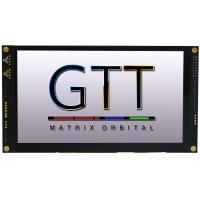
| Cost | Durability | Feedback |
|---|---|---|
A resistive touch screen is a clear overlay which uses physical pressure to detect touch input. It consists of two layers, a flexible outer layer and glass inner layer, separated by an air gap which is maintained by micro dots. The layer configuration used by this technology can accommodate only single touch events, and reduces the transmittance, or brightness, of the display underneath by 20% to 30%. However, resistive touch overlays are often more light weight than their capacitive counterparts, offer higher precision, and can be activated with ordinary implements, including gloved hands. A resistive touch panel will typically be less durable than a capacitive version, with a scratch hardness value of only 3 and lifespan rating of 1 million touches. However, the versatility of this technology and low cost has made it attractive to industrial applications that require advanced input.
Resistive Touch is available on GTT, Intelligent and Parallel Displays.
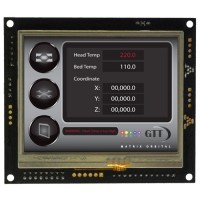
| Cost | Durability | Feedback |
|---|---|---|
A membrane keypad is a key input device, typically externally mounted, which uses physical pressure to detect the closure of switches. It consists of one or more metal domes that connect two separated conductors. This construction results in a slim, light weight profile that provides built-in tactile and audio feedback. Key life is typically estimated at 1 million touches. Membrane keypads often include an adhesive backing that is used to affix them to a rigid surface. The simplicity of this low cost technology makes it attractive to industrial applications that require minimal input.
-200x200.jpg)
| Cost | Durability | Feedback |
|---|---|---|
A silicone keypad is a key input device, typically integrated into a bracket design, which uses physical pressure to detect the closure of switches. It consists of one or more flexible silicone keys tipped with carbon pads that connect two metal traces when depressed. This construction results in feedback that is quiet, but tactile, with an estimated lifespan of 100 million presses. A silicone keypad is highly customizable in terms of shape and colour, and can even be backlit. A buzzer or motor can be added to improve feedback. The added customizability and low price of this interface makes it attractive for simple, cost sensitive consumer and industrial applications.
| Cost | Customization | Feedback |
|---|---|---|
A piezo, or piezoelectric, buzzer is a simple audio device that converts an electric voltage into a tiny movement within a piezoelectric material that is amplified into a single tone using a resonator. This device generates a single frequency sound at a set volume; our products offer a selectable frequency range of 1Hz to 65KHz, and a volume of up to 95dB. We also provide an easily configurable duration setting between 1 millisecond and 65 seconds. This device is useful for providing auditory feedback to the user, especially for button activation or warnings.
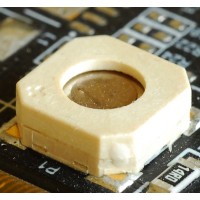
| Cost | Customization | Feedback |
|---|---|---|
A speaker is an audio device that converts an electrical audio signal into a sound using magnetic induction that is amplified using a diaphragm. This device can emulate a number of different sounds and pitches using pulse width modulation (PWM) driving techniques. The EVE series provides a library of different sounds, from harp to cowbell, which can be played on a speaker. This device is useful for providing more advanced sound effect feedback to the user.

| Cost | Customization | Feedback |
|---|---|---|
Haptic motors provide feedback to the user, by causing the entire display to gently vibrate. This sensation is normally used to indicate a button press but can be used for any number of events. In GTT Designer, it is possible to change the frequency and duration of the vibration.
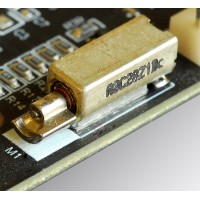
| Cost | Customization | Feedback |
|---|---|---|
A GPO, or General Purpose Output, is a switchable output that can be used by a Matrix Orbital display to control relays and other external devices. These pins can be controlled via software to either source 5V when on or sink 0V when off, with up to 15mA of current. These devices are useful for controlling peripheral devices in an industrial or an embedded application where IO pins are at a premium.
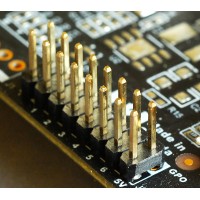
| Cost | Customization | Feedback |
|---|---|---|
An LED, or Light Emitting Diode, is a switchable output that emits a specific frequency of light when activated. Matrix orbital displays typically use bi-colour LEDs that can be software controlled to produce red, green, or orange light. These devices are useful for providing fast visual status updates to the user.
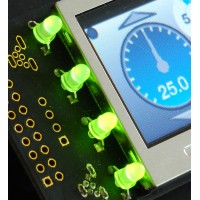
| HMI Input | Cost | Durability | Feedback |
|---|---|---|---|
| Capacitive Touch |
|
|
|
| Resistive Touch |
|
|
|
| Membrane Keypad |
|
|
|
| Silicone Keypad |
|
|
|
| HMI Feed Back | Cost | Customization | Feedback |
|---|---|---|---|
| Piezo Buzzer |
|
|
|
| Speaker |
|
|
|
| Vibration Motor (Haptic) |
|
|
|
| General Purpose Outputs (GPOs) |
|
|
|
| LEDs |
|
|
|